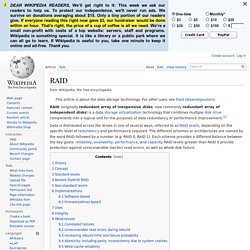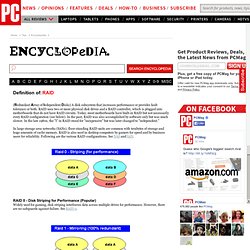

RAID. RAID (originally redundant array of inexpensive disks; now commonly redundant array of independent disks) is a data storage virtualization technology that combines multiple disk drive components into a logical unit for the purposes of data redundancy or performance improvement.[1] History[edit] Although not yet using that terminology, each of the five levels of RAID named in the paper were well established in the art prior to the paper's publications, for example: Around 1983, DEC began shipping subsystem mirrored RA8X disk drives (now known as RAID 1) as part of its HSC50 subsystem.[3]Around 1988, the Thinking Machines DataVault used error correction codes (now known as RAID 2) in an array of disk drives.[4] A similar approach was used in the 1970s on the IBM 3330.[5]In 1977, Norman Ken Ouchi at IBM filed a patent disclosing what was subsequently named RAID 4.[6]In 1986, Clark et al. at IBM filed a patent disclosing what was subsequently named RAID 5.[7] Concept[edit] Standard levels[edit]

Standard RAID levels. In computer storage, the standard RAID levels comprise a basic set of RAID configurations that employ the techniques of striping, mirroring, or parity to create large reliable data stores from multiple general-purpose computer hard disk drives (HDDs).

The most common types are RAID 0 (striping), RAID 1 and its variants (mirroring), RAID 5 (distributed parity), and RAID 6 (dual parity). RAID levels and their associated data formats are standardized by the Storage Networking Industry Association (SNIA) in the Common RAID Disk Drive Format (DDF) standard.[1] RAID Levels Explained. If you've ever looked into purchasing a NAS device or server, particularly for a small business, you've no doubt come across the term "RAID.

" RAID stands for Redundant Array of Inexpensive (or sometimes "Independent") Disks. In general, a RAID-enabled system uses two or more hard disks to improve the performance or provide some level of fault tolerance for a machine—typically a NAS or server. Fault tolerance simply means providing a safety net for failed hardware by ensuring that the machine with the failed component, usually a hard drive, can still operate. Fault tolerance lessens interruptions in productivity, and it also decreases the chance of data loss.
The way in which you configure that fault tolerance depends on the RAID level you set up. RAID Overview RAID is traditionally implemented in businesses and organizations where disk fault tolerance and optimized performance are must-haves, not luxuries. RAID Definition from PC Magazine Encyclopedia. (Redundant Array of Independent Disks) A disk subsystem that increases performance or provides fault tolerance or both.

RAID uses two or more physical disk drives and a RAID controller, which is plugged into motherboards that do not have RAID circuits. Today, most motherboards have built-in RAID but not necessarily every RAID configuration (see below). In the past, RAID was also accomplished by software only but was much slower. In the late 1980s, the "I" in RAID stood for "inexpensive" but was later changed to "independent. " Free RAID Calculator - Caclulate RAID Array Capacity and Fault Tolerance. RAID Made Easy.
What is RAID, why do you need it, and what are all those mode numbers that are constantly bandied about?

RAID stands for “Redundant Array of Independent Disks” or “Redundant Array of Inexpensive Disks,” depending on who you talk to. Note that the word array is included in the acronym, so saying “RAID array,” as a lot of people do, is redundant. Back when hard drives were less capacious and more expensive, RAID was created to combine multiple, less-expensive drives into a single, higher-capacity and/or faster volume. On top of that, it was designed to facilitate redundancy, also known as fault tolerance or failover protection, so that the array and its data remain usable when a drive fails. You’ll often hear about 1-disk or 2-disk redundancy, which refers to the number of drives that can fail while the array remains viable. Redundancy is important for a small business, as drive failure does happen.